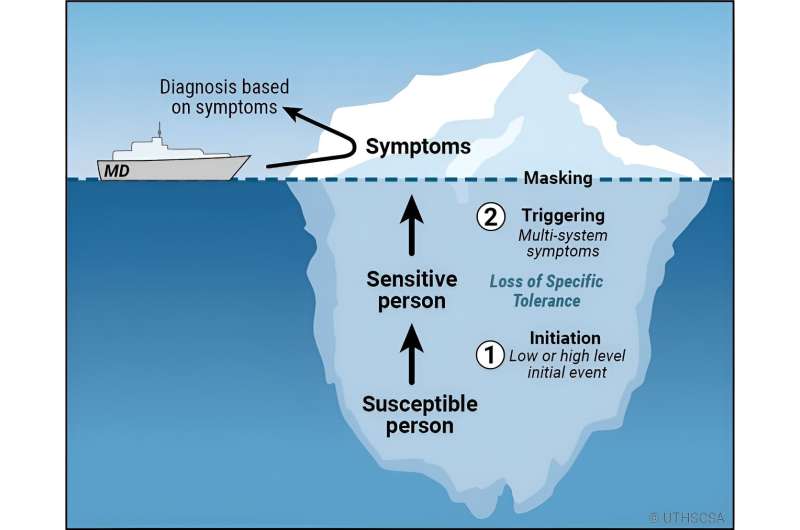This article has been reviewed according to Science X's editorial process and policies. Editors have highlighted the following attributes while ensuring the content's credibility:
fact-checked
trusted source
proofread
Toxic molds, fossil fuels, antibiotics linked to chemical intolerance: Survey

What initiates chemical intolerance (CI)? In a newly released survey of thousands of U.S. adults, respondents most frequently cited exposures to biological sources, such as mold and algae "blooms," and/or fossil fuels, their combustion products and synthetic chemical derivatives such as pesticides, plastics and persistent organic pollutants.
It's an issue in the news, as toxic mold spawned by the moisture left behind by flood waters from Hurricane Idalia could lead to severe health problems for people who suffer from chemical intolerance. This mold also could initiate the condition in some individuals.
"Everyone should avoid prolonged exposure to mold whenever possible," said physician-researcher Claudia Miller, MD, MS, from The University of Texas Health Science Center at San Antonio, also called UT Health San Antonio. "Research has increasingly shown that toxic mold is much more dangerous than was previously recognized."
In the survey, published in the journal Environmental Sciences Europe, 17.5% of participants who attributed their illness to an initiating event cited mold exposure as the perceived cause of their chemical intolerance. CI is estimated to afflict up to 20% to 30% of Americans, Miller, senior author of the study, said.
Participants were queried about antibiotic use, as well. According to the results, prolonged courses of antibiotics were associated with an increased risk of CI.
The survey data also indicate that with each additional initiating exposure respondents can recall, the odds of their reporting CI nearly triple.
"With climate change contributing to more severe storms and more intense flooding worldwide, the danger posed by toxic mold is likely to increase dramatically in the near future," Miller said. "As mold exposure is known to be a major initiator, the likelihood of more and more people with chemical intolerance is also unfortunately on the rise."
TILT
The study furthers understanding about how a two-stage disease process called TILT (toxicant-induced loss of tolerance) begins. The survey asked 10,981 people to state their self-perceptions about the events that began the downward spiral through TILT and into chemical intolerance.
"TILT can develop rapidly, for instance after a pesticide exposure, or gradually if someone is working or living in a setting such as a moldy building," Miller said. She first proposed TILT in 1996 and is professor emerita of family and community medicine at UT Health San Antonio.
Unknown origins
"Initiating events commonly go unrecognized and therefore unreported, leaving triggers and symptoms as the only documented components," Miller said. "This has thwarted our understanding of the actual causes of TILT."
Participants completed an 80-question online survey called the Personal Exposure Inventory. It included items concerning individuals' medical diagnoses and personal exposures including antibiotic use.
Chemical intolerance was assessed using the Quick Environmental Exposure and Sensitivity Inventory (QEESI) developed by Miller 25 years ago. It is a validated, self-administered questionnaire now used worldwide to differentiate individuals with CI from the general population. One-fifth of survey respondents met the QEESI criteria for chemical intolerance.
Toxic mold
Exposure to mold was the most frequently mentioned initiating event on the Personal Exposure Inventory. "In recent years, global warming has led to more rainfall, floods, hurricanes, roof leaks and water intrusion, resulting in increased mold growth indoors," said paper co-author Raymond F. Palmer, Ph.D., a biostatistician and professor of family and community medicine at UT Health San Antonio.
Mold was followed in rank order by exposures to pesticides (cited by 13.8% of respondents), medical/surgical procedures (12.6%), remodeling/new construction (12.0%), fires/combustion products (7.2%) and breast implants (1.8%).
Antibiotics
Respondents answered questions pertaining to how many courses of antibiotics they had completed for specific types of infections. Antibiotics prescribed for infections categorized as skin, tonsil, gastrointestinal, prostate, sinus, wound and pneumonia were most strongly associated with chemical intolerance.
"Our search for the underlying causes of CI represents a much-needed addition to the CI/TILT literature, whose principal focus has been on triggers that elicit CI symptoms from day to day with no attempt to determine what initiated TILT," Miller said.
'A cohesive narrative'
"Taken together, our data support the idea that the person who reports multiple symptoms, multiple intolerances and recurrent infections as well as a history of exposure events is sharing a cohesive narrative, one that points to physiological (as opposed to psychosomatic) explanations of their oft-confusing complaints," she said.
Although certain exposures such as medical/surgical procedures may be difficult to avoid, reducing exposures to contaminants related to pesticide use, new construction/remodeling and mold is possible and should be the focus of efforts to prevent future CI/TILT, the authors wrote.
Digging in
Finally, they encourage practitioners who see patients with medically unexplained symptoms—currently one in four primary care patients—to consider administering the QEESI. "'TILTed' individuals who report brain fog, memory, mood and concentration difficulties often receive referrals to psychiatrists, psychologists or social workers who explore their psychosocial environments but do not ask about changes in their actual—physical and chemical—environments," Miller said.
"If initiating exposures such as pesticides, toxic mold, implants and combustion products are not stopped, sensitivities can spiral out of control."
Teaching in schools of medicine, public health, architecture and engineering has not kept pace with these toxicants, many of which are new to the planet since World War ll, Miller noted. This is exacerbated by energy conservation efforts that have increased exposures to indoor air toxicants, she said.
More information: Claudia S. Miller et al, What initiates chemical intolerance? Findings from a large population-based survey of U.S. adults, Environmental Sciences Europe (2023). DOI: 10.1186/s12302-023-00772-x



















